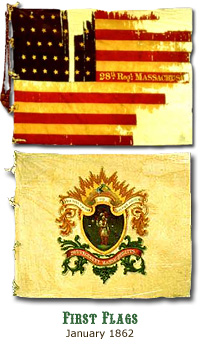Flags
of the 28th Massachusetts (continued)
 he 28th
Massachusetts Volunteer Infantry
received nine flags during the Civil War. Five were issued by the
Office of the Adjutant General of the Commonwealth of Massachusetts,
three were given to the regiment by the City of Boston, and one was
presented by Brig. Gen. Thomas Francis Meagher, who commanded the Irish
Brigade during 1862 and early 1863.
he 28th
Massachusetts Volunteer Infantry
received nine flags during the Civil War. Five were issued by the
Office of the Adjutant General of the Commonwealth of Massachusetts,
three were given to the regiment by the City of Boston, and one was
presented by Brig. Gen. Thomas Francis Meagher, who commanded the Irish
Brigade during 1862 and early 1863.
 Mustered into the service of the United
States on December 13, 1861, the 28th received its first flags about a
month later. Gov. John A. Andrew presented the regiment with national
and state colors on January 10, 1862.
Mustered into the service of the United
States on December 13, 1861, the 28th received its first flags about a
month later. Gov. John A. Andrew presented the regiment with national
and state colors on January 10, 1862.
Smaller than regulation size, the first
national flag measured roughly four and half feet on the pole and about
six feet on the fly. It had painted gold stars on a dark blue canton.
The state flag was almost identical to other
state regimental flags issued at the time. It has a white field without
fringes and has the early issue state seal and regimental ribbon placed
in the center.
Boston Mayor Joseph Wightman presented the 28th with a distinctive
green regimental flag a week later. Each side carried a different
elaborate painting, resplendent with patriotic and Irish symbols.
A fairly accurate drawing of the obverse
side appeared in the Boston Irish Catholic newspaper The
Pilot, along with an article
describing the January 18, 1862, presentation ceremony. To
distinguish this first green flag from
the three others issued to the 28th Massachusetts during the course of
the Civil War, state archivists have always referred to it as the
"Pilot flag."

By the end of the war's first year, Union infantry regiments generally
carried only two flags, one of which was always the national banner.
Reflecting his men's desire that the 28th Massachusetts be identified
as an Irish-American regiment, first commanding officer Col. William
Monteith elected the Pilot flag over the standard state color.
Never taken by the regiment into the field,
the state flag was presumably kept in storage for the duration of the
war. The 28th carried its first national color and the Pilot through
most of its first year of service, and under fire at Seccessionville
(James Island), 2nd Bull Run, Chantilly, South Mountain, and Antietam.
Continued
>

